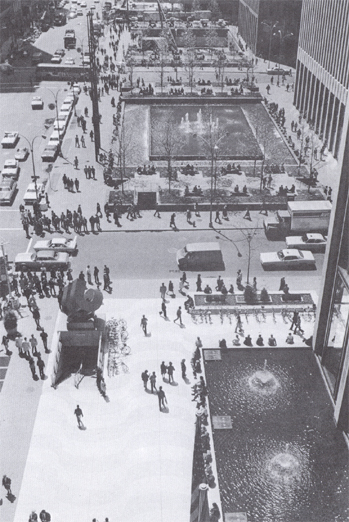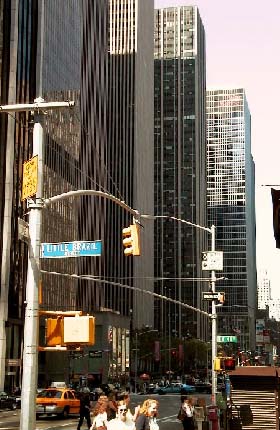|
||
|
Public Contribution in
High-Rise Building Design
|
||
|
@ New York City
|
||
|
Rockefeller
Center : The City within the City
|
||
|
History
of Rockefeller Center
|
||
|
(continue)
|
||
|
History of Rockefeller
Center(Continue)
|
||
| The Expansion | ||
| 5 years later there are the new proposal for expansion. Esso of New Jersey informed that they need way more room than they had. In 1941 they fully rented and start to get the profit. Esso has no choice but to move out and make there own building. The cente had no problem to fulfill the space of Esso but if it let Esso who is one of the major tenants say good bye, it can be a bad sign to the public about the status of the center. | ||
| Even John D, Jr. has no desire to do, but in 1944 he approved the post war plan to expand the center of 33 story building on 51st street due north of Rockefeller Plaza. As Laurence Rockefeller, jr's Son become the chairman, he think about the plan to avoid this emergency. He bought the property on the sixth ave. in 1945 which at that time is the days of speakeasies and ugly railroad. For the long range of the future this thing need to be clean and then one day the modern city can develop here. | ||
| His vision was rewarded in 1950s, Time Inc. decided to move out from the center. First they think about building their own head quarters on Park Ave., the fashionable residence district. If there are the sleeky glass building stand there, people may think as the effect from the growth the center, that the symbol of Progressive of the Center was turned to become dim. | ||
| Determined not to let it happen, Rockefeller Group convince the Time Inc to stay in their own property, in December 1959, Time and Life building was opened on some what awkward angle to the rest of the center. | ||
|
||
| John D Jr. Died in the following year at age 86. Once again the center found the cause the expand. 1963, again, Esso company that was so success. And known as Exxon, planed to move across the avenue to stand side by side with Time and Life building. The center quietly bough the land across sixth avenue, not only for the new building of Exxon but for 2 more soaring building to the south of it. And like the time building, each of the building will have an attractive plaza in the front. | ||
| With the concept "coordinate architectural complex with the old center across the street" and complete in 1973, western half the center was linked to the old center via superb underground pedestrian malls. They claimed as the hugely successful urban Concept. | ||
| At Present; | ||
|
||
| There are 50 millions people around the world visiting Rockefeller Center every year most of them do walking along the promenade, Skating Rink, Private Streets also see some art works around the center. Furthermore, shopping around the area as a continuation from the great brand on Fifth Avenue. However, in terms of identity, not so many people know that the 4 buildings across the Avenue of Americas (Sixth Ave.) area also belong to Rockefeller Group. The obvious reason is because there is no link in terms of architectural finishing or any physical element that can link both area together at all. Only Concourse underground that link all the system together but this link never be seen by any pedestrian or visitors to the center. Therefore in my review for Rockefeller Center, I divided the Center into 2 building groups which I identify it as the "Classical Complex" for the brown limestone-finished building complex and the "Modern Complex for all the building across Avenue of the Americas that was build in the 1950s to 1970s. | ||

